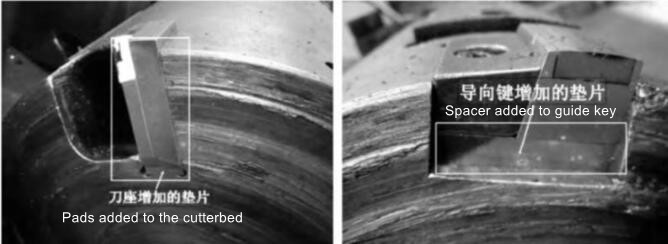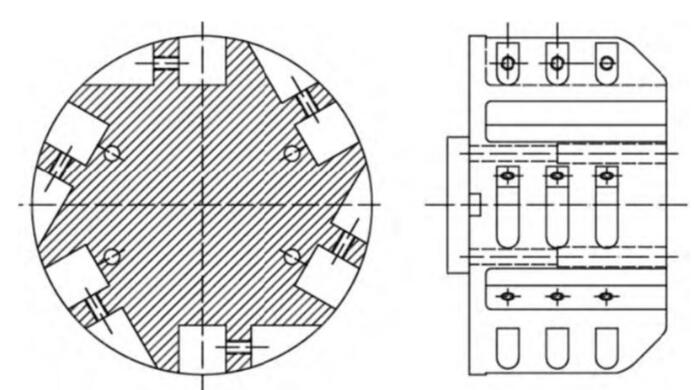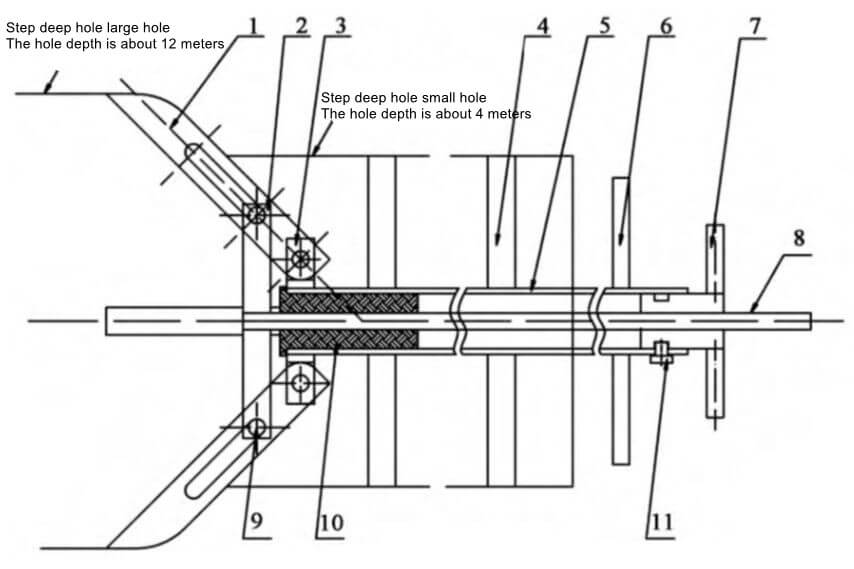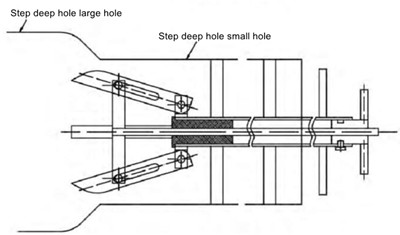The research and analysis of the current technology of deep hole machining of large forgings has been insufficient, aiming to improve the processing method and improve processing efficiency.
Through years of continuous research and development, our company has achieved a high level of extreme manufacturing in deep hole manufacturing technology for large forgings. However, the current deep hole manufacturing technology for large forgings still presents problems such as: B. low processing efficiency and certain quality and safety risks. Based on a large number of practical facts and processing experiences, we analyze the shortcomings of current deep hole processing technology and carry out targeted technical research to improve the deep hole processing efficiency of large forged products by more than 20% and also improving processing improves product quality.
1. Product Overview
Large forging for a half-speed rotor of a nuclear power plant, e.g. B. Material 25Cr2Ni4MoV, length 15226mm, body diameter 1955mm, the center hole is intended for through hole, small hole diameter 240mm, hole depth 3175mm, large hole diameter 330mm, hole depth 12051mm, The gradual transition of the center hole and the axis hole form an angle of 45°, the cylindricity of the entire deep hole should be 0.5mm, as shown in Figure 1. 
Figure.1 Forging Size
2. Analysis of the current situation of deep hole machining
Analysis of current deep hole machining technology shows the following shortcomings.
- (1) When machining deep holes in large forgings, pilot and finish holes are machined with a floating tool. Traditional machining with a floating tool can improve the surface roughness of the inner hole and facilitate subsequent hole grinding, but the machining efficiency is low, which makes the reaming process longer. In addition, deep holes and polygonal holes occur during machining, resulting in repeated hole repairs, reducing machining efficiency and putting machining quality at risk.
- (2) Grinding hole connection. The volume of conventional honing is small and the efficiency is low.
- (3) The step transition is difficult to process and the processing efficiency is low.
- (4) For the cleaning member after completing the hole and the cleaning member after the joint magnetic inspection probe, the step transition of the step hole is difficult to clean by traditional methods, affecting the work efficiency. The method used before is to use a rope to pull from the large hole to the inner hole transition and rub the hole manually. This work requires a high physical and physical level and is very laborious and at the same time inefficient. And there is a huge safety risk for people entering the 330mm diameter deep hole to work.
3. Technical solutions
3.1 Improvement of semi-finished hole connection processing method
Deep hole machining of large forged parts can be divided into five steps: grouping, reaming, semi-finishing, finishing and grinding. In the original machining method, the small hole is machined from Φ240mm to Φ239.5mm after the grouping reaches Φ230mm, and then the hole is machined to Φ239.5mm with the floating knife and finally honing is carried out; the large hole of Φ330mm is machined to Φ320mm after the seating reaches 230mm, and then the hole is machined with the friction drill of Φ300mm and Φ320mm to Φ320mm, and then the hole is machined to Φ329 with the floating knife 0.5mm machined . Φ329.5mm hole diameter and finally sharpened. The traditional floating cutter is less efficient, and deep hole rounding and polygonal drilling occur during machining, resulting in repeated hole repairs and lower quality.
The comparative study shows that the friction drill is more efficient than the floating tool and the straightness of the center hole is good, but the surface roughness of the machined hole is low.
This machining method eliminates the floating tool and the hole is directly machined to Φ238mm and Φ328mm with a reamer and then ground. By adding spacers to the friction drilling tool holder and guide groove area (see Fig. 2), the Φ230mm and Φ320mm friction drill bit can process Φ238mm and Φ328mm deep holes respectively, which is equivalent to making a drill of friction of Φ238mm and Φ328mm.
Because the efficiency and stability of friction drilling machining are higher than floating knife machining, the new machining method not only reduces the quality risk when machining internal holes, but also improves machining efficiency.
3.2 Research and application of highly efficient honing technology
Due to the low roughness of the inner hole machined with friction drill, a diameter of 2 mm is generally left in the inner hole, which leads to a significant increase in the amount of honing work. Taking a large hole as an example: The above machining method is to machine a hole with a floating knife with a diameter of Φ329.5mm and hone. The improved machining method consists of machining the hole with a diameter of Φ328mm with a countersink drill and honing. The amount of honing work has tripled, and the efficiency of honing has a great influence on the efficiency of the entire deep hole machining.
The traditional honing process, whose removal rate is generally less than 0.5 mm, mainly aims to obtain greater surface roughness. The highly efficient honing technology in this document removes 2mm waste through honing, which actually combines fine hole processing and grinding into one. Taking the example of machining Φ330mm deep holes, the improved machining method can save 8 days of machining time compared with the traditional machining method, which greatly improves the machining efficiency of deep holes.
Through research and comparison, the new honing oil stone has been adapted according to the high-efficiency honing processing properties with high removal volume and high efficiency. The new honing oil stone has sulfur monomers and various sulfides added in a certain proportion and offers greater advantages in honing removal, wear resistance and stability.
By continuously testing the best technical parameters of the new honing stone during processing, the relevant parameters for center hole honing are 3-4rpm for workpiece speed, 20-30rpm for honing head speed, and 3.5- 4.5m/min for the honing head feed speed.
Improved and highly efficient honing technology breaks the traditional meaning of honing. Great advances have been made in the amount of material removed and the efficiency of honing processing. In practical application, a 12 m deep hole could be created in a half-speed rotor that was sharpened from Φ328 mm to 330 mm in just 4 days.
3.3 Improving processing technology at stage transition
According to the stepped hole structure, the bottom slope insert is redesigned (see Fig. 3) to improve the processing quality and efficiency of the stepped transition. Use a combination of coarse and fine chamfer machining methods to make the stepped hole uniform and ensure that the bottom surface of the machined hole has a uniform knife coating, so that the grinding hole achieves high surface roughness.
By polishing the bottom of the stepped hole, the hole bottom grinding head is designed and manufactured (see Fig. 4). Nylon blocks are inserted into the six slots of the grinding head, and then the size is rotated to match the shape of the bottom of the stepped hole. After combining with sandpaper, the polishing process can be completed well to achieve the required surface roughness with high efficiency.
3.4 Manufacture and application of hole polishing devices
Due to its structure, the stepped transition of the center hole cannot be cleaned effectively by traditional methods, which significantly affects the inspection results of the center hole. Manual access for deep cleaning of holes, limitations, lack of safety, low efficiency. Special enhanced hole cleaning device is provided to effectively solve the above problems.
As shown in Figure 5, the hole reamer is mainly composed of a work support arm (4 parts), a movable support (1 part), a fixed support (1 part), a central support (2 parts), a main body (1 piece), a wrench (2 pieces), a drive nut (1 piece), a drive chuck (1 piece), a screw pin (8 pieces), a center guide sleeve (1 piece) and a positioning pin (1 piece). 
Figure 2 Φ 238mm and Φ 328mm Reaming Drill 
Fig. 3: Roughing and finishing cutters for flooring 
Fig. 4 Floor grinding head with stepped hole 
Fig. 5 Operating status of the hole polishing device
1 working arm; 2-Active support; 3-Firm support; 4-Central Support; 5-head body; 6 keys; 7-drive nut; 8-drive chuck; 9 screw pin; 10-Central guide sleeve; 11 pin positioning
The method of using the hole reamer is to first move the drive chuck toward the left side of Figure 5 by turning the drive nut. The movable support then moves to the left and the four work support arms shrink to a total size smaller than the size of the small hole. The entire device enters through the end of the small hole as shown in Figure 6. After the jig reaches the deep hole stage, rotate the drive nut to move the drive chuck to the right side of Figure 5. Then the bracket movable moves to the right and the four working arms open to the design size and fully adhere to the deep hole step, as shown in Figure 5. Turning the key rotates the entire device. The working arms can effectively clean impurities such as oil and mud in the deep hole stage. By turning the drive nut, the working arms can shrink to an overall size smaller than the size of the small hole. Finally, the entire device is removed. The manufacture and use of hole reaming tools allows for a safe and efficient reaming process outside the hole. 
Figure 6: State of contraction of the hole reamer

























































